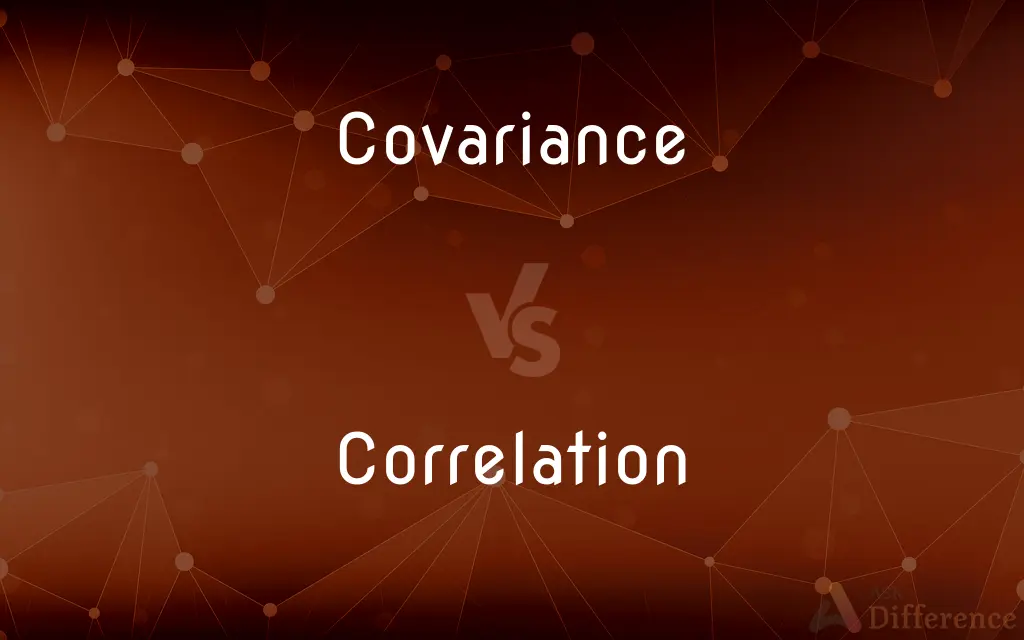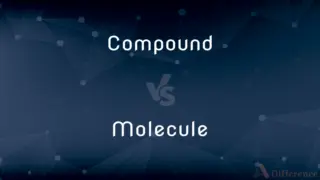Covariance vs. Correlation — What's the Difference?
By Tayyaba Rehman — Updated on September 22, 2023
Covariance measures the directional relationship between two variables, while Correlation measures both the strength and direction of that relationship.

Difference Between Covariance and Correlation
Table of Contents
ADVERTISEMENT
Key Differences
Covariance and Correlation are statistical measures used to analyze the relationship between two variables. Covariance indicates whether two variables tend to increase or decrease simultaneously. If one variable goes up while the other also goes up, then the covariance is positive. On the other hand, Correlation not only indicates the direction of the relationship but also quantifies its strength on a scale of -1 to 1.
In analyzing data sets, Covariance provides insights into how two variables change concerning each other. However, it does not provide information on the strength of the relationship. Conversely, Correlation provides a more comprehensive view, giving an indication of both direction and strength, with 1 meaning perfect positive correlation and -1 indicating perfect negative correlation.
One limitation of Covariance is that its value is not standardized. It can range from negative infinity to positive infinity, making it sometimes challenging to interpret. In contrast, Correlation is standardized, so its value is always between -1 and 1, offering more intuitive understanding.
Another aspect to consider is that while Covariance can provide initial insights into how variables might change together, Correlation is more robust. It gives a clearer picture of how closely the variables are related. For instance, a high correlation indicates a strong relationship, but high covariance doesn't necessarily imply a strong relationship.
Comparison Chart
Definition
Measures directional relationship between variables
Measures strength and direction of the relationship
ADVERTISEMENT
Value Range
Can range from negative infinity to positive infinity
Ranges from -1 to 1
Interpretation
Value alone can be challenging to interpret
Value offers clear interpretation
Units
Has units of the product of the units of the two variables
Dimensionless (no units)
Sensitivity to Scale Changes
Sensitive to changes in scale
Not sensitive to changes in scale
Compare with Definitions
Covariance
A numerical measure that denotes simultaneous changes in two variables.
Studying Covariance can provide insights into market dynamics.
Correlation
An indication of the strength and direction of a linear relationship between two random variables.
A Correlation of -1 means a perfect inverse relationship.
Covariance
A statistic denoting the joint variability of two variables.
The Covariance matrix helped in understanding the relationships in the dataset.
Correlation
An assessment of the linear relationship between two sets of data.
The study found a strong Correlation between sugar intake and cavities.
Covariance
A descriptor of how two variables vary together.
Analysts often use Covariance to understand potential investment risks.
Correlation
A standardized measure of how two datasets relate.
The Correlation coefficient is always between -1 and 1.
Covariance
A measure indicating the extent to which two variables change in tandem.
The Covariance between stock A and stock B was positive, suggesting they move together.
Correlation
A descriptor of the linear association between variables.
Despite the common belief, Correlation does not imply causation.
Covariance
An indication of directional relationship between two datasets.
A negative Covariance implies that as one variable increases, the other decreases.
Correlation
In statistics, correlation or dependence is any statistical relationship, whether causal or not, between two random variables or bivariate data. In the broadest sense correlation is any statistical association, though it commonly refers to the degree to which a pair of variables are linearly related.
Covariance
In probability theory and statistics, covariance is a measure of the joint variability of two random variables. If the greater values of one variable mainly correspond with the greater values of the other variable, and the same holds for the lesser values (that is, the variables tend to show similar behavior), the covariance is positive.
Correlation
A relationship or connection between two things based on co-occurrence or pattern of change
A correlation between drug abuse and crime.
Covariance
(Statistics) A statistical measure of the tendency of two random variables to vary in the same direction (called positive covariance) or in an opposite direction (called negative covariance) over many observations. Covariance is equal to the summed products of the deviations of corresponding values of the two variables from their respective means.
Correlation
(Statistics) The tendency for two values or variables to change together, in either the same or opposite way
As cigarette smoking increases, so does the incidence of lung cancer, indicating a positive correlation.
Covariance
(Physics) The principle that the laws of physics have the same form regardless of the system of coordinates in which they are expressed.
Correlation
An act of correlating or the condition of being correlated.
Covariance
(statistics) A statistical measure defined as given two real-valued random variables X and Y, with expected values and .
Correlation
A reciprocal, parallel or complementary relationship between two or more comparable objects.
Covariance
(object-oriented programming) The conversion of data types from wider to narrower in certain situations.
Correlation
(statistics) One of the several measures of the linear statistical relationship between two random variables, indicating both the strength and direction of the relationship.
Covariance
A statistical measure of the relationship of two variables, formed by multiplying the difference of each variable from its mean, both variables being measured at the same time, and averaging all such products.
Correlation
(algebra) An isomorphism from a projective space to the dual of a projective space, often to the dual of itself.
Covariance
Statistical measure of the variance of two random variables measured in the same mean time period
Correlation
Reciprocal relation; corresponding similarity or parallelism of relation or law; capacity of being converted into, or of giving place to, one another, under certain conditions; as, the correlation of forces, or of zymotic diseases.
Correlation
A reciprocal relation between two or more things
Correlation
A statistic representing how closely two variables co-vary; it can vary from -1 (perfect negative correlation) through 0 (no correlation) to +1 (perfect positive correlation);
What is the correlation between those two variables?
Correlation
A statistical relation between two or more variables such that systematic changes in the value of one variable are accompanied by systematic changes in the other
Correlation
A statistic that measures the degree to which two variables move in relation to each other.
The Correlation between height and weight in the sample was 0.75.
Common Curiosities
Which measure is dimensionless, Covariance or Correlation?
Correlation is dimensionless.
Can Covariance have values beyond -1 and 1?
Yes, Covariance can have values ranging from negative infinity to positive infinity.
Is Covariance sensitive to the units of data?
Yes, Covariance is sensitive to the units of the variables.
Can a high Covariance indicate a weak relationship?
Yes, high Covariance doesn't necessarily imply a strong relationship.
Can Covariance be used to indicate strength of relationship?
Covariance indicates direction but not the strength of the relationship.
Why is Correlation considered a more robust measure than Covariance?
Because Correlation gives standardized values and is easier to interpret.
Does Correlation of zero mean no relationship?
A Correlation of zero means no linear relationship, but there might be a non-linear association.
Which measure gives both direction and strength, Covariance or Correlation?
Correlation provides both direction and strength of the relationship.
Is Correlation affected by changes in the scale of data?
No, Correlation remains unchanged with scale alterations.
What are the most common types of Correlation coefficients?
Pearson's and Spearman's are common Correlation coefficients.
How does scaling impact Covariance values?
Scaling can significantly change Covariance values.
Is it accurate to say that Correlation implies causation?
No, Correlation does not imply causation.
What does a negative Correlation coefficient signify?
A negative Correlation indicates an inverse linear relationship between variables.
In which situations is Covariance commonly used?
Covariance is often used in finance for portfolio diversification strategies.
What value of Correlation indicates a perfect linear relationship?
A Correlation value of 1 or -1 indicates a perfect linear relationship.
Share Your Discovery

Previous Comparison
Boy vs. Buoy
Next Comparison
Compound vs. MoleculeAuthor Spotlight
Written by
Tayyaba RehmanTayyaba Rehman is a distinguished writer, currently serving as a primary contributor to askdifference.com. As a researcher in semantics and etymology, Tayyaba's passion for the complexity of languages and their distinctions has found a perfect home on the platform. Tayyaba delves into the intricacies of language, distinguishing between commonly confused words and phrases, thereby providing clarity for readers worldwide.















































